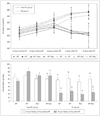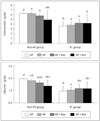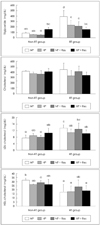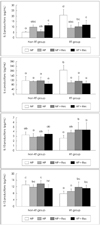Abstract
Figures and Tables
 | Fig. 1Body weight and food intakes of rats was measured before and after radiation. Each diet was supplied from 12th day prior to irradiation treatment with irradiation dose of 17.5 Gy in experimental groups, and was continued until 10th day after radiation treatment. Means with different letters are significantly different from each other at p < 0.05 as etermined by Duncan's multiple test. a < b. |
 | Fig. 2Total protein in serum of rats was measured 10th day after radiation. Each diet was supplied from 12th day prior to irradiation treatment with irradiation dose of 17.5 Gy in experimental groups, and was continued until 10th day after radiation treatment. Means with different letters are significantly different from each other at p < 0.05 as determined by Duncan's multiple test. a < b < c < d. |
 | Fig. 3Lipid status in serum of rats was measured 10th day after radiation. Each diet was supplied from 12th day prior to irradiation treatment with irradiation dose of 17.5 Gy in experimental groups, and was continued until 10th day after radiation treatment. Means with different letters are significantly different from each other at p < 0.05 as determined by Duncan's multiple test. a < b < c < d. |
 | Fig. 4IL-2, IL-6, IL-10 and IL-12 productions in serum of rats were-measured 10th day after radiation. Each diet was supplied from 12th day prior to irradiation treatment with irradiation dose of 17.5 Gy in experimental groups, and was continued until 10th day after radiation treatment. Means with different letters are significantly different from each other at p < 0.05 as determined by Duncan's multiple test. a < b < c < d. |
Table 2

NP, AIN-93M Diet HP, Modified AIN-93M with 30% protein; NP+Res, oral administration of 50 mg/kg b.w. resveratrol in saline every other day; HP + Res, Modified AIN-93M with 30% protein plus oral administration of 50 mg/kg b.w. resveratrol in saline every other day; Hb., hemoglobin Hct., hematocrit MCV, mean corpuscular volume MCH, mean corpuscular hemoglobin MCHC, mean corpuscular hemoglobin concentration. Values are mean ± SD. Means with different letters are significantly different from each other at p < 0.05 as determined by Duncan's multiple test. a < b < c < d
Table 3

NP, AIN-93M Diet HP, Modified AIN-93M with 30% protein; NP + Res, oral administration of 50 mg/kg b.w. resveratrol in saline every other day; HP + Res, Modified AIN-93M with 30% protein plus oral administration of 50mg/kg b.w. resveratrol in saline every other day. Values are mean ± SD. Means with different letters are significantly different from each other at p < 0.05 as determined by Duncan's multiple test. a < b < c
Table 4

NP, AIN-93M Diet HP, Modified AIN-93M with 30% protein; NP+Res, oral administration of 50 mg/kg b.w. resveratrol in saline every other day; HP + Res, Modified AIN-93M with 30% protein plus oral administration of 50mg/kg b.w. resveratrol in saline every other day. Values are mean ± SD. Means with different letters are significantly different from each other at p < 0.05 as determined by Duncan's multiple test. a < b < c < d
Table 5

NP, AIN-93M Diet HP, Modified AIN-93M with 30% protein; NP + Res, oral administration of 50 mg/kg b.w. resveratrol in saline every other day; HP + Res, Modified AIN-93M with 30% protein plus oral administration of 50 mg/kg b.w. resveratrol in saline every other day. Values are mean ± SD. Means with different letters are significantly different from each other at p < 0.05 as determined by Duncan's multiple test. a < b




 PDF
PDF ePub
ePub Citation
Citation Print
Print



 XML Download
XML Download